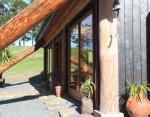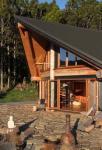Re-Thinking Home Building
Thinking outside the square has always been natural for John Donovan, an Xpat Kiwi, who has returned to New Zealand after 25 years abroad. A clean green lifestyle close to family members in Auckland was the primary goal. The house he designed and built is definitely green, and certainly not square.
John and partner Sharon bought land in West Auckland overlooking the seaside village of Huia and then went about looking for an eco-design house in which to live out their babyboomer golden years.
Given generous time to research and think about the design, a new type of dwelling emerged from the landscape and appealed to John’s love of big trees. “We looked at straw bale, mud brick, rammed earth, and then whole logs became our focus for building...but not in the usual log cabin style.”
John did a log building course primarily to understand the methodology, and hired a young draftsman to interpret his early drawings. An A-frame style log -walled studio looked promising enough to inspire final working drawings. Eventually the conventional log walls were axed and a ‘log frame’ house he named
‘Tehuia Twin Peaks’ became a reality.
This 200 sq.m open-plan studio/ show home situated in a very private three-acre wild meadow, surrounded by a Kauri forest, national park and the peaks of the Waitakere Ranges, has inspired a lot of public interest. Tehuia Log Homes Ltd was founded to provide those interested with consultation and Twin Peaks log frames.
The company was founded according to principals called ‘The Hanover Principals’. Being a sustainable company in the building industry and keeping as much as possible to strong Green principles may seem problematic, but John is adamant that the only successful future for New Zealand is clean and green.
“That means we walk the talk,” says John. “Trees grow very well here, but most commercial forests are soft Pine, sent offshore for cheap packing crates and pulp. We can do much better for our country by value-adding good timber here in New Zealand. There are many excellent tree types that have been used for building in Europe and Asia over thousands of years. Why not here?”
John selects the logs he needs from a living Douglas Fir forest. Then, in collaboration with Jason Cruze of Draftworks, they fell and use draught horses to bring the logs out of the forest with minimal impact on the forest. Big draw-knives are used to de-bark the logs with virtually no waste. Age old and well-proven log building techniques he calls ‘slow building’, are used to shape the notches, saddles and tenons which tightly lock the log frame together.
Hand crafting the first Twin Peaks log frame this way was a highlyskilled, time and labour-intensive journey but lessons learned are now being applied to a commercially viable ‘log kit frame’. The frame is delivered on a logging truck and re-erected on the client’s site in a few days.
Once the frame is erected, truly organic materials like straw bale or mud brick can be installed between each of the huge outer log frame posts and then finished with cob and earth plaster. Or as in the Tehuia show-home, a conventional more modern and contemporary look can be achieved.
The show-home has untreated Douglas Fir rafters and joists milled by John in his own mill. Macrocarpa ship-lap weather boards are painted black and macrocarpa tongue and groove eves are clear stained.
The house is packed with ecowool insulation under Gib-board. A natural stone and lime-wash paint on the interior gives an attractive earth plaster look and feeling of warmth. Unlike normal log walls, the plaster board allows more scope for interior decoration and highlights the log frame structure. Big log beams feature on the interior and exterior - what you see is what you get - strength and integrity from sun-grown building materials of natural beauty.
The words ‘sustainability’, ‘eco home’, ‘passive solar’, are used a lot these days but this house actually achieves all three. The low arc winter sun dives under the spectacular northern peak, deep into the house, to heat the concrete slab, and the outer black-painted macrocarpa siding accumulates wall heat.
John chose a COLORSTEEL® iron roof for its impressive low carbon footprint and economical cost. In Karaka Green, it fits the country aesthetic and eco house credentials. Marcus Bond of the Metalcraft Group supervised an efficient crew that delivered an excellent product on time and on budget. It cleanly collects rainwater and very simply works to protect the building and people from the elements.
An open plan, with a void to the upstairs level, allows warm air in winter to circulate the entire house so there’s no need to artificially heat rooms or fan force air through ceiling ducts.
To test and prove his passive solar design, John did not connect the Bosco wood burner to its chimney this first winter. Amazingly, at least in the Auckland region, this house does not need any extra heat source other than the sun. In fact, the only heat source, other than the sun, exists under the bathroom tiles on timers for early morning and evening comfort.
The engineered downstairs oak floor and wool carpets upstairs add insulation and ambient feeling of natural warmth. The joinery is Western Red Cedar with German hardware that can be tilted open at the top, for risk-free ventilation, or opened normally.
Twin Peaks has huge expanses of glass: bi-folds and french doors and huge windows upstairs and down, double-glazed with no window coverings or blinds. Once again this validates the effectiveness good passive solar design.
The downstairs bi-folds open to a space that flows out onto the 23 tonnes (so far) of handpicked stone that is gradually being added to the patio and surrounds of the house. Warmed by the sun, these stones hold heat well providing warmth when the sun goes down and the cooler winds of the West Coast blow off the Tasman Sea.
Manuka wood smoke from cooking in the stone fire-pit completes the scene for this earth, wind and fire house.
The open plan downstairs is essentially one big room, which opens up in the North, South, East and West.
A small laundry/ utility/entrance way and bathroom in the West make a simple room divider between the kitchen and media room. Sound and light play beautifully off the big log beams and candlelight really accentuates the natural beauty and patterns of drawknifed Douglas Fir.
The kitchen is cedar and black granite to reflect the cedar joinery and black outside walls. Bi-fold windows and doors open the kitchen to the outdoor living areas in the North and West and in the East the kitchen’s central granite bench contrasts with the natural honey coloured refrectory table made from off-cuts from the timber mill.
Upstairs, accessed via a spiral staircase, is a large master bedroom, ensuite and personal loft space with views out under eves through the beautifully- crafted cedar joinery. Here the sloping ceilings and proximity to huge posts and ridge logs create an intimate space for quite relaxation.
Water is heated primarily by a heat-pump designed and built here in New Zealand. It extracts heat energy from the air temperature and heats the hot water far beyond what is needed. The savings in electricity from this keeps running costs very low as there is no heating other than a small amount of under-floor in the bathrooms.
Smart wiring for data, cable TV, video and sound plus LED lighting make this house suitable for a modern 21st Century lifestyle or simple organic living off the grid. Either way, the Tehuia Twin Peaks walks the talk. An authentic Kiwi design for a sustainable future.
The Hannover Principles
1. Insist on rights of humanity and nature to co-exist
2. Recognise interdependence.
3. Respect relationships between spirit and matter.
4. Accept responsibility for the consequences of design.
5. Create safe objects of long-term value.
6. Eliminate the concept of waste.
7. Rely on natural energy flows.
8. Understand the limitations of design.
9. Seek constant improvement by the sharing of knowledge.





